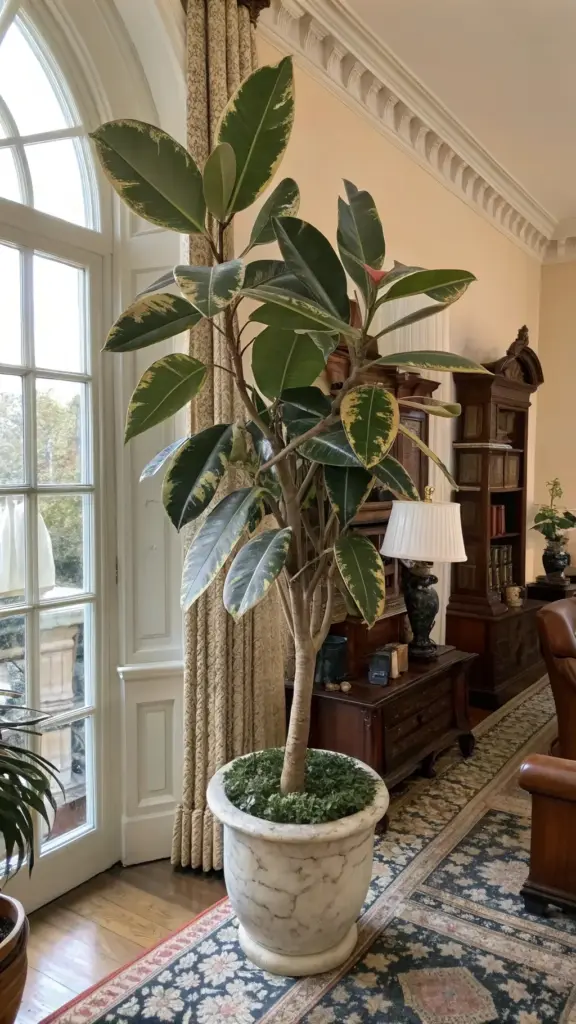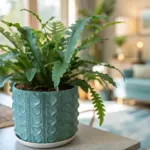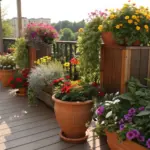7. Ficus elastica ‘Doescheri’ – The Vintage Treasure

My grandmother had a massive Ficus elastica ‘Doescheri’ in her sunroom that I remember from childhood visits. Back then, I had no idea I was looking at plant royalty – a variety that’s been captivating collectors for over a century.
When I inherited that same plant after she passed, I finally understood why she treasured it so much. This isn’t just a houseplant – it’s a living piece of horticultural history that connects generations of plant lovers.
A Century of Plant Collecting History
The historical significance of ‘Doescheri’ in plant collecting goes way back to the early 1900s. This variety was one of the first variegated rubber plants ever cultivated for indoor growing.
Plant collecting circles in Victorian and Edwardian eras considered ‘Doescheri’ the ultimate status symbol. Having one in your conservatory meant you were serious about horticulture and had the connections to acquire rare specimens.
What’s fascinating is that many modern varieties can trace their lineage back to ‘Doescheri’ genetics. This plant is literally the grandmother of most variegated rubber plants we see today.
Botanical gardens worldwide still maintain original ‘Doescheri’ specimens from the early 1900s. Some of these plants are over 100 years old and still producing new growth – talk about longevity!
The cultivation techniques developed for ‘Doescheri’ became the foundation for growing all variegated rubber plants. Early plant collectors figured out the care requirements through decades of trial and error.
Those Classic Cream and Green Patterns
The cream and green variegation on ‘Doescheri’ has this timeless elegance that never goes out of style. Unlike the bold patterns of modern varieties, this plant offers subtle, sophisticated coloring.
Variegation patterns tend to be more irregular and organic-looking compared to newer cultivars. Each leaf tells its own story with unique cream sections that blend seamlessly into deep green areas.
The cream coloration has this warm, buttery quality that’s different from the stark white you see in some modern varieties. It’s like comparing vintage lace to modern synthetic fabric – both beautiful, but with completely different character.
Edge variegation is particularly stunning on mature leaves, creating natural borders that look hand-painted. The cream margins frame each leaf like expensive artwork matting.
Seasonal variations in the variegation are subtle but noticeable – spring growth tends to have more pronounced cream sections than winter leaves.
Mature Specimen Beauty That Takes Time
Mature specimen characteristics are where ‘Doescheri’ really shines. My grandmother’s plant had a trunk diameter of nearly 6 inches after decades of growth – absolutely magnificent.
Aging beauty in this variety is something special. The bark develops this gorgeous mottled pattern, and the overall structure becomes more tree-like with age.
Leaf size on mature specimens can reach 8-10 inches long, creating this incredible canopy effect. The variegation becomes more pronounced as the plant establishes itself over years.
Branching patterns develop character over time, creating natural sculptures that are impossible to replicate with younger plants. Each mature ‘Doescheri’ has its own personality shaped by decades of growth.
The root system on old specimens is incredibly robust, allowing them to support impressive top growth. I’ve seen 50-year-old plants that look more like indoor trees than houseplants.
Heirloom Care and Preservation Secrets
Heirloom plant care requires a different mindset than caring for modern varieties. These plants have survived decades using traditional care methods that still work best today.
Preservation techniques I learned from my grandmother include consistent watering schedules and minimal fertilization. Over-fertilizing can actually damage the delicate variegation patterns in older specimens.
Repotting mature plants is a serious undertaking that should only happen every 5-7 years. The root systems are extensive, and disturbing them too frequently can cause significant stress.
Propagation from heirloom specimens requires patience and respect for the plant’s age. I take cuttings sparingly to preserve the mother plant’s energy for continued growth.
Winter care adjustments become more critical with age. Older plants seem more sensitive to temperature fluctuations and dry indoor air during heating season.
Pest prevention is crucial because treating infestations on valuable heirloom plants is risky. Regular inspection and preventive measures are worth the extra effort.
Traditional Home Setting Perfection
Creating focal points with ‘Doescheri’ in traditional home settings is pure magic. This plant was literally designed for classic interior styles like Victorian, Colonial, and traditional American.
Traditional home settings benefit from the plant’s mature, established presence. Unlike trendy varieties that might look dated, ‘Doescheri’ has timeless appeal that works across decades.
My favorite placement is in formal living rooms with antique furniture and rich fabrics. The cream and green variegation complements traditional color palettes beautifully.
Bay windows in older homes seem made for mature ‘Doescheri’ specimens. The architectural details of traditional windows frame these plants perfectly.
Pairing with antiques creates incredible visual harmony. I’ve seen stunning combinations with vintage brass planters, antique plant stands, and period-appropriate accessories.
Library or study settings work wonderfully too. The sophisticated variegation adds life to book-lined walls without overwhelming the scholarly atmosphere.
Entryway statements with large ‘Doescheri’ plants create immediate impressions of elegance and established taste. Guests know they’re entering a home where quality and tradition matter.
Conclusion
These seven rare rubber plant varieties represent the pinnacle of indoor plant collecting – each one a living work of art that transforms any space into a sophisticated sanctuary.
From the painterly patterns of ‘Shivereana’ to the dramatic darkness of ‘Abidjan’, these specimens offer something truly special for the discerning plant parent.
Remember, investing in rare varieties isn’t just about the plants themselves; it’s about creating a home environment that reflects your unique style and passion for beautiful living things.
Ready to start your hunt for these botanical treasures?
Begin with local specialty nurseries, connect with plant collector groups in your area, and don’t forget to follow your favorite plant influencers for sourcing tips!









GIPHY App Key not set. Please check settings